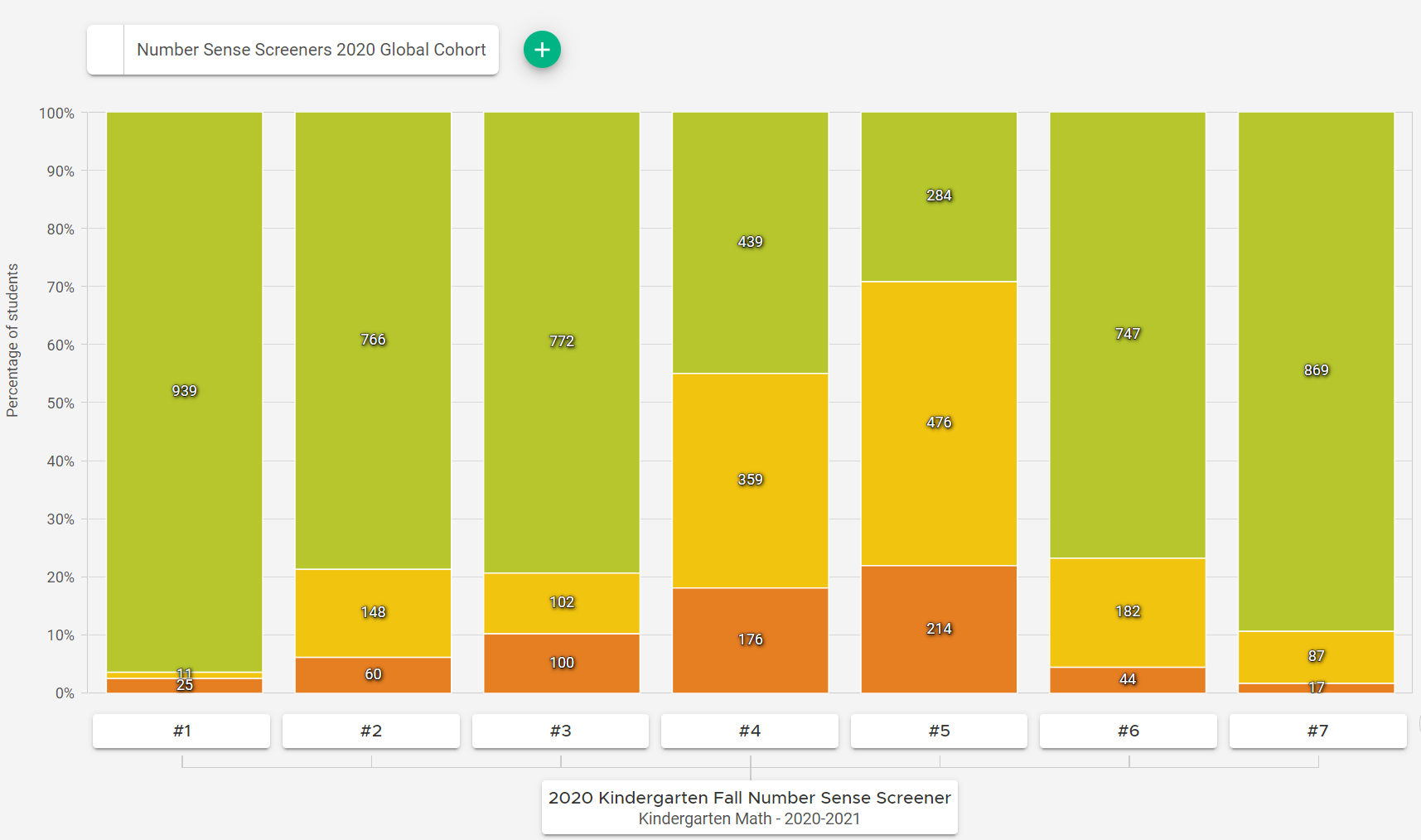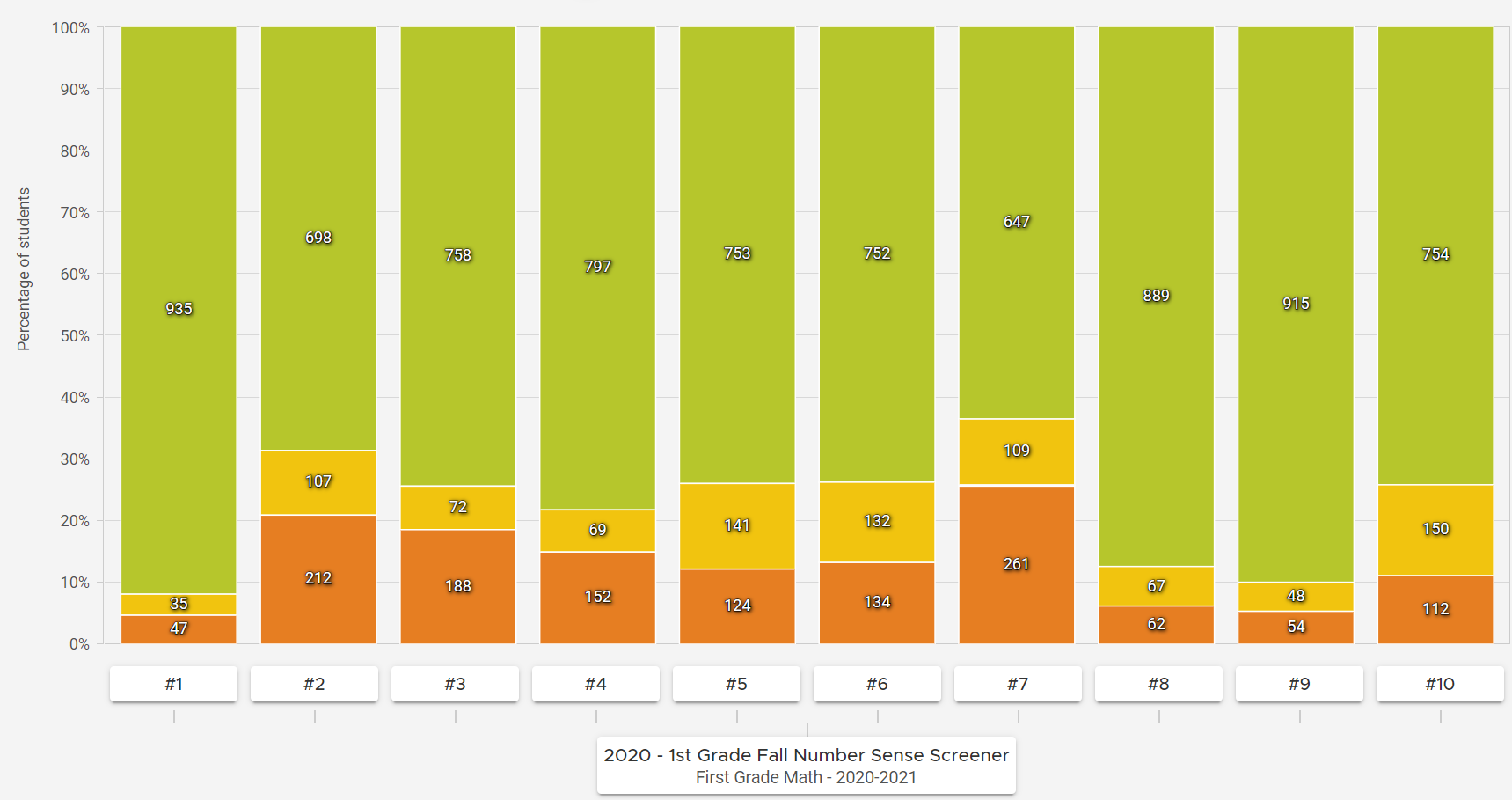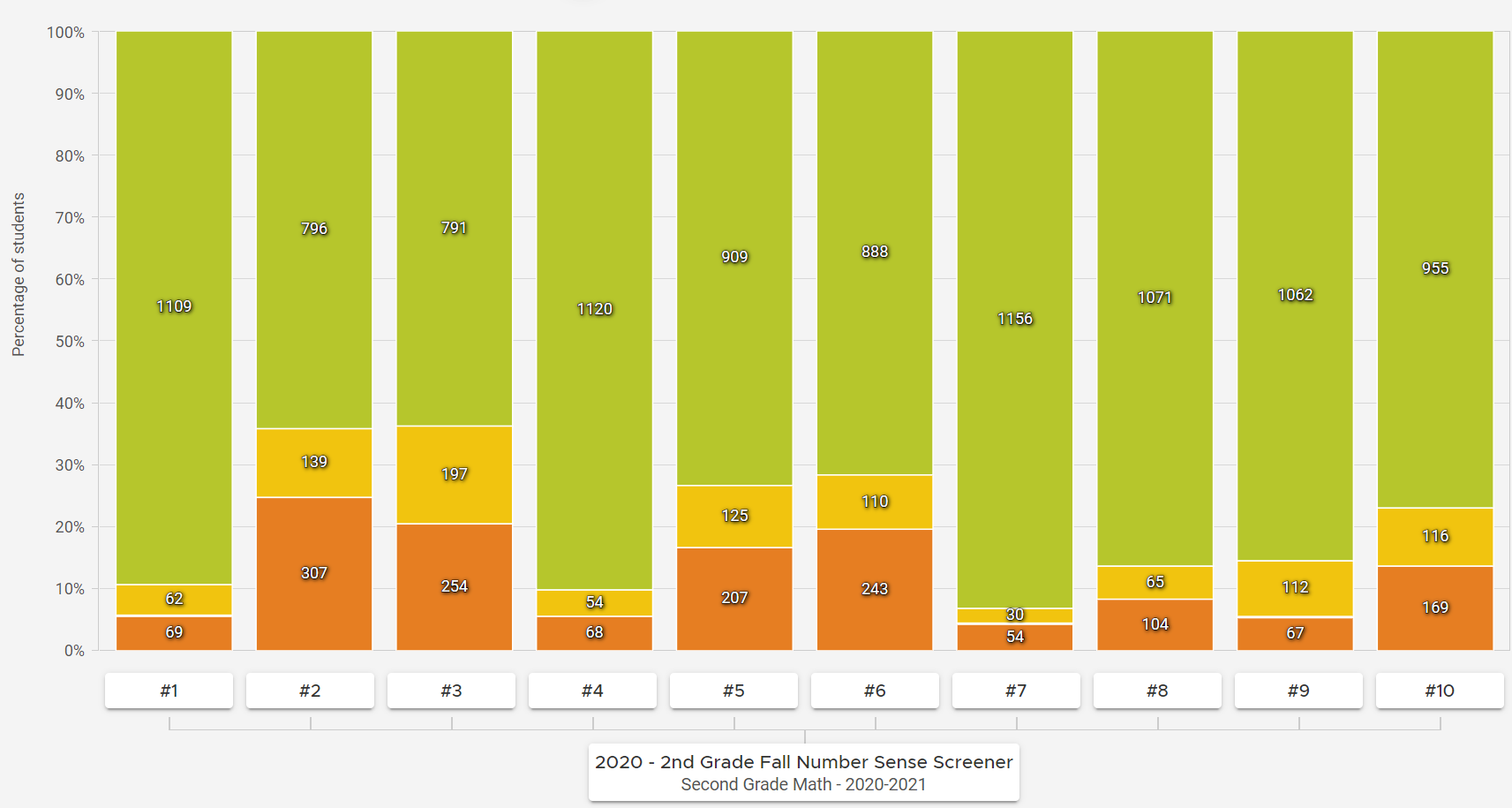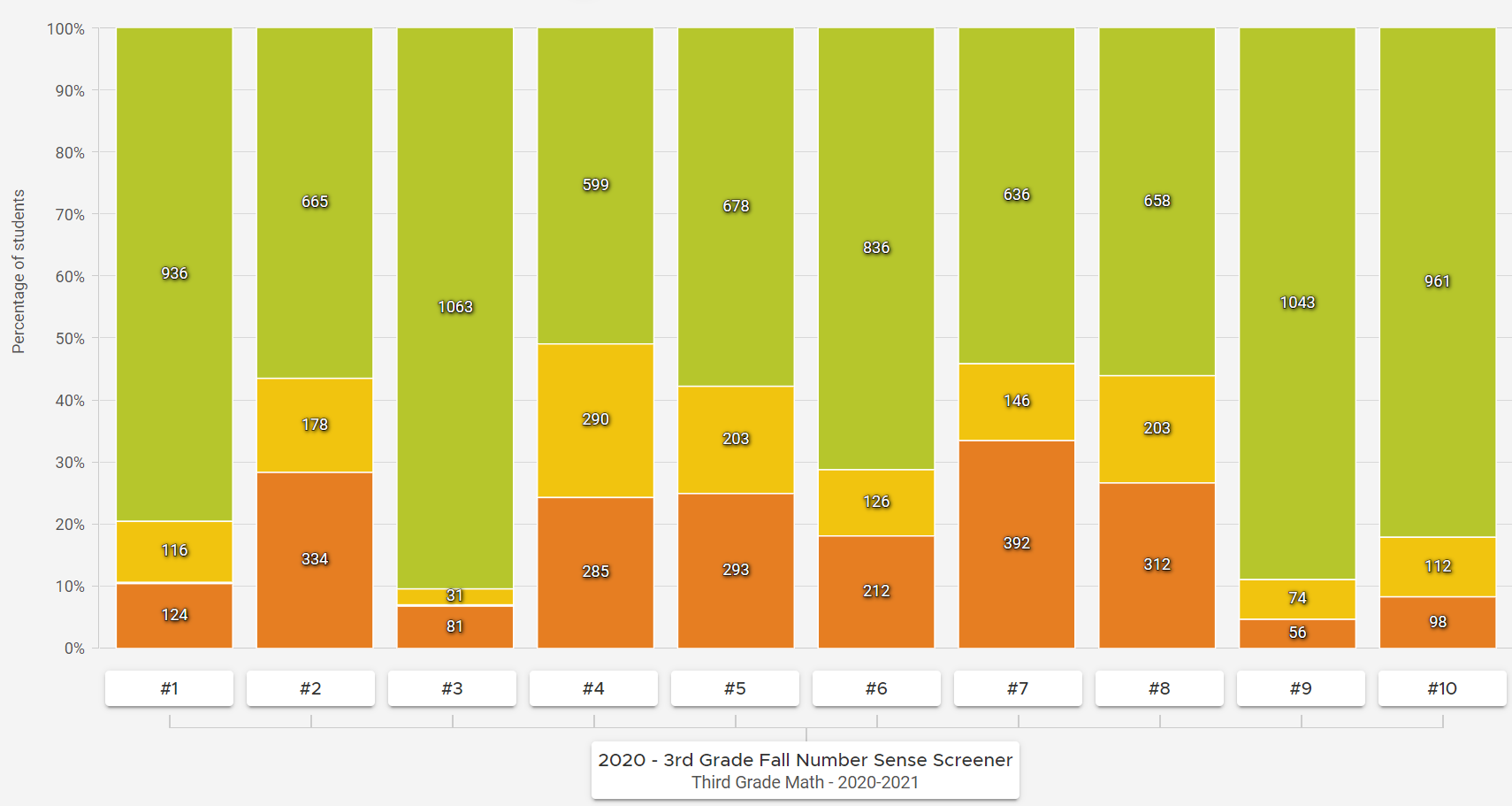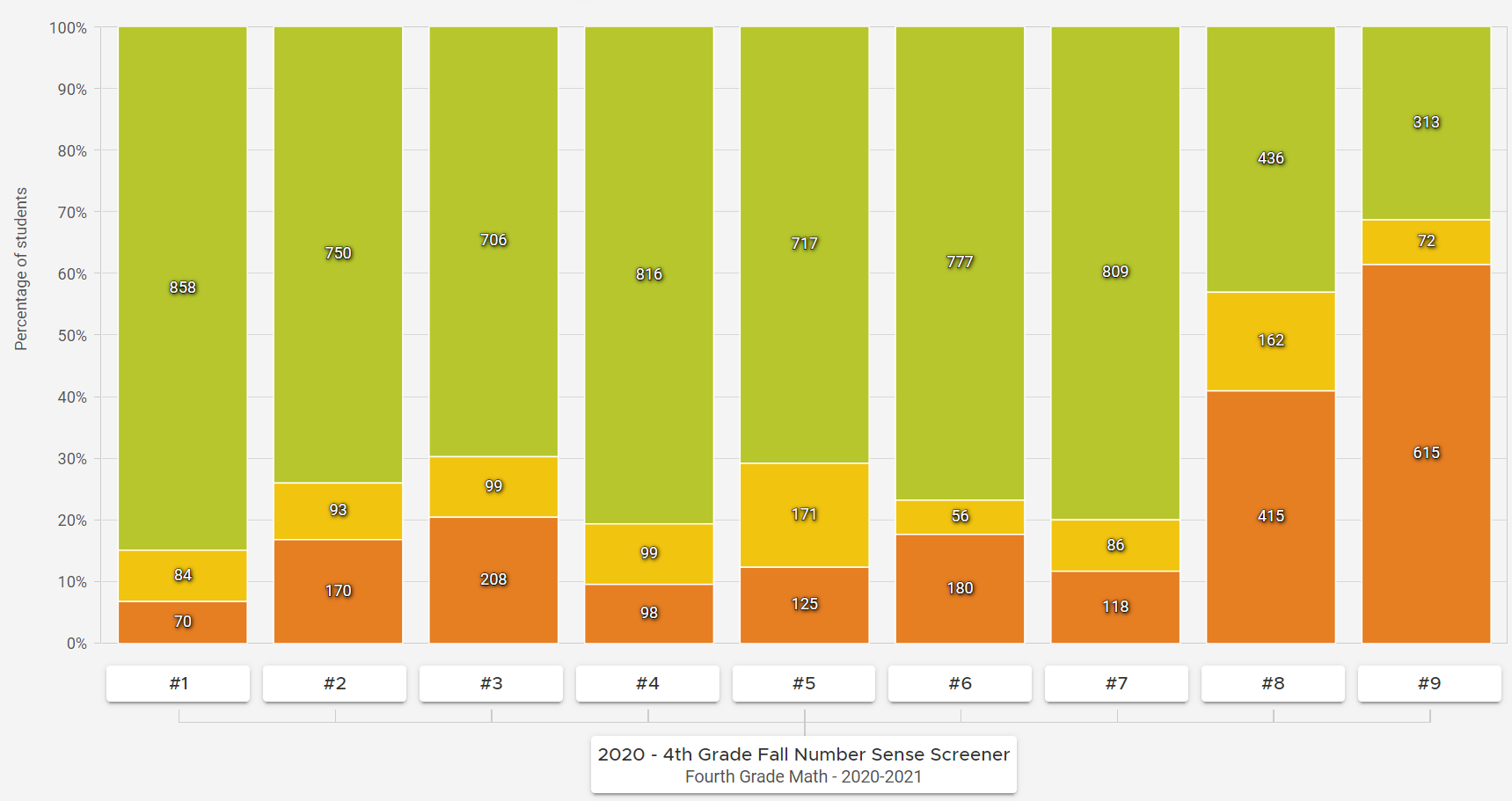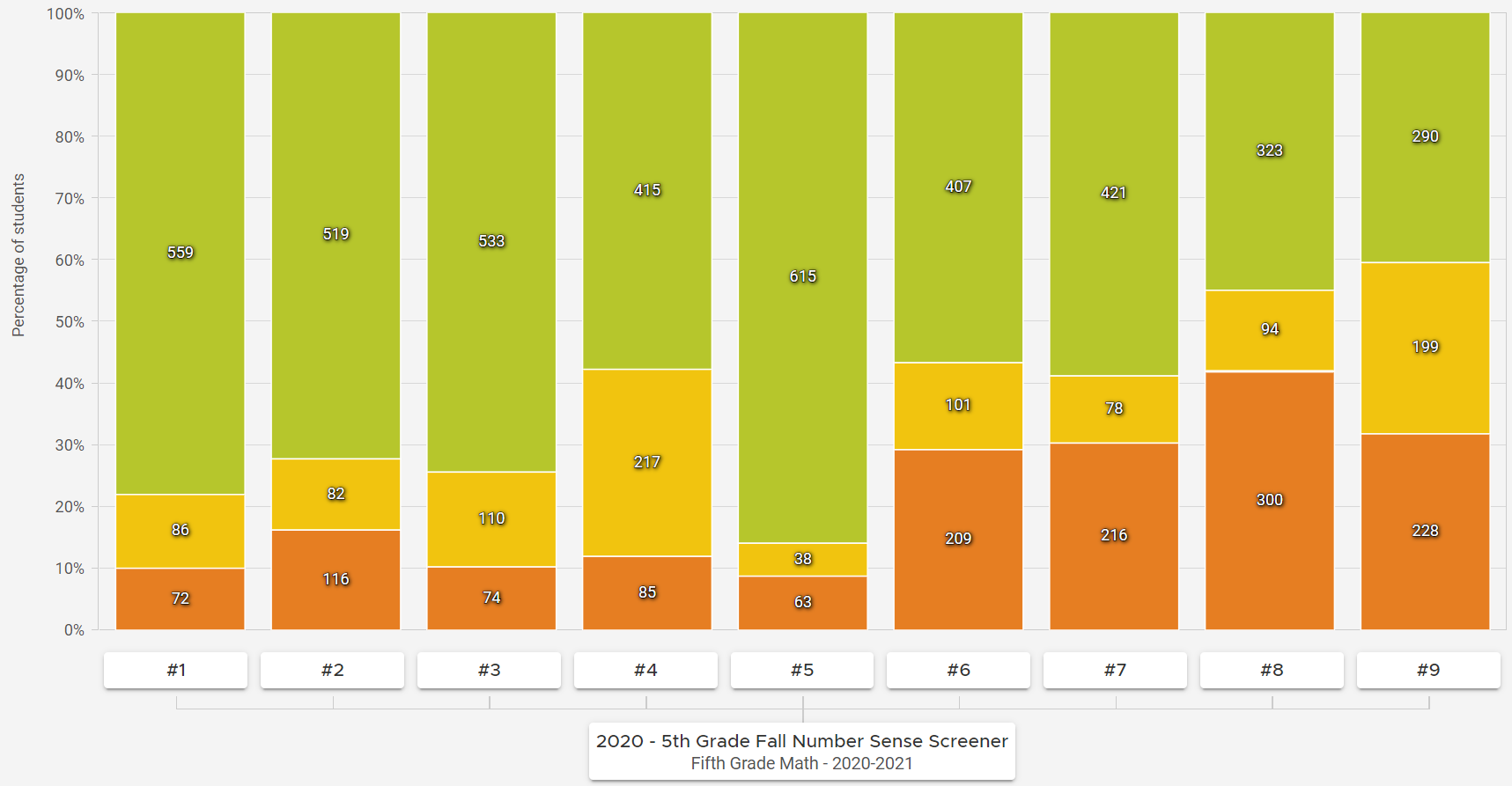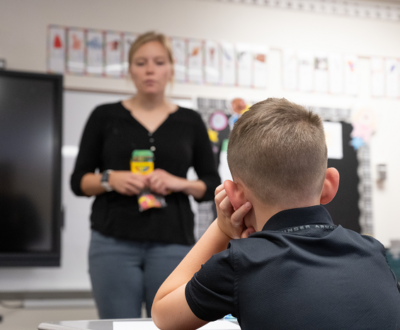Revised versions of the Universal Screeners for Number Sense (USNS) were released in July 2020 and the initial interest has been exciting. Unique downloads of the Screeners are approaching 3,000 as of the date of this article. Forefront, which supports the collection and analysis of classroom assessment data, helped nearly 20 districts across the country and abroad to manage their Universal Screeners for Number Sense fall results this inaugural year. The anonymized, aggregated results from these diverse districts make up Forefront’s Screeners Global Cohort. These national results establish a new baseline for the assessments.
This article briefly covers highlights from each of the grade level screeners for kindergarten through 5th grade. It refers to the item analysis report in Forefront for each grade. If you wish to explore your own class, school or district results alongside the Screeners Global Cohort, contact our team today to request a trial or pilot.
Kindergarten
This graph from Forefront provides an item by item representation of the kindergarten Number Sense Screener fall results. Note that the numbers below each bar correspond to the Screener questions and the numbers on the bars are the total number of students in each category.
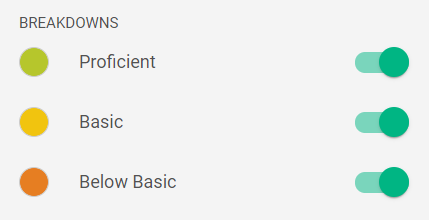
Interestingly, Fall 2020 results are remarkably consistent with results from previous years.
Highlights:
Question 1, “Count to ten,” shows that only 25 students of the 985 who were interviewed were unable to count to ten. Eleven others (the yellow slice right about the orange on the bottom) were able when given a second chance. The small number of students who were unsuccessful with this task reflects the degree of urgency that it implies. The Screeners help predict trouble to come, which can be prevented when action is taken.
Question 7, “Show me 5 fingers. Ok, put them down. Now show me 3 fingers,” is an addition for this revision. It is interesting how closely those results echo the count-to-10 results and encouraging to see that most kindergarten students are able to do this.
First Grade
Again, it is encouraging to see that the results of the Fall 2020 Number Sense are not far out of range of those that we have seen in other years.
Highlights:
Question #1 asks the students to start counting and allow them to count through 22 to score “in the green.” As with kindergarten, the small numbers of students who are unable to successfully complete this task reflects the urgency of the situation.
Question #2 is an additional counting task new to the 2020 revisions. Here we ask students to start counting at 38. About 70% of students were able to count to 42 on their first attempt. Another almost 10% were able to do it on a second attempt, and a full 20% of students were unable to complete the count to 42. Counting is important, and students benefit when teachers persist in their efforts to ensure that all students are strong counters before leaving 1st grade.
Question #7 is where more students struggled in this fall’s assessment. This has consistently been the case over the past 8 years of this assessment.
Second Grade
Tasks #9 and #10 are new to the 2020 revisions. Task 9 first presents a strip of 10 dots, then an additional 6 more dots. The student is asked how many there are. 67 students out of the sample of more than 1100 were unable to answer 16. This suggests that targeted instruction and progress monitoring should be put in place promptly.
For task #10, once the student establishes that there are now 16 dots, the interviewer presents the student with another strip of 10. Students in the lowest category cannot establish that there are now 26 dots. The 115 students in the yellow group needed to count by ones to arrive at 26. This suggests that some small-group work to support students before the significant place value work of 2nd grade kicks in. Remember, students, by most state standards, are to add and subtract numbers to 1000 by the end of the year. These two problems point to unfinished learning that teachers and interventionists should address in order to achieve this ambitious goal.
Third Grade
Highlights:
Tasks #2 and #7 have consistently been the among most challenging of the third grade screener over the years. Task #2 asks students to count back starting at 303, and task #7 asks students to mentally subtract 50-24. These issues with subtraction are precursors to the troubles that teachers witness when students begin working with division. Third grade presents unique challenges, as students continue to learn about place value and master multi-digit addition and subtraction, embark on multiplication and division, and begin working with fractions. The issues with place value can easily get overlooked with all there is to accomplish. However, it is important to address them.
Task #4 points to the foundational understandings that students will need for the development of multiplicative thinking. This task presents the student with 12 objects and asks them to make 4 groups of the same size. The ability to construct equal-sized groups is a critical developmental milestone. Third grade students begin to manipulate and count equal-sized groups. Some students will need repeated opportunities to create and draw equal sets in order to establish these necessary concepts.
Fourth Grade
The revised question #9, a fractions-on-a-number-line task, included context. The previous version had a simple line running from 0 – 2. This new version describes a racecourse. In the original version, students were asked where ⅓ and ⅔ belong on that line. With the new contextual information, students must figure out how far along the line s/he will be after they have run ⅓ mile and then ⅔ mile.
Historically fewer than 20% of students have correctly placed both fractions between 0 and 1 with ⅓ to the left of ⅔. This fall, slightly more than 30% of students in the Forefront Global Cohort were successful with this task. This improvement is encouraging, but nevertheless, this continues to demonstrate that the ability to place fractions on number lines, an expectation of 3rd graders in most states, is a high bar for the many students. Whether this is a cognitive or curricular question, or a combination of the two, is something we as math educators probably need to confront.
Fifth Grade
The Fifth Grade Fall Screener was revised to better calibrate the tasks and the overall distribution of results. The distribution of the number sense fall results now places about 48% of students in the proficient range over all. Alternatively, about 25% are in the basic and below basic ranges. If the Screener is a test to help recognize where teachers need to act with urgency, these revisions help minimize the number of false positives.
The fluency tasks were significantly modified. The former versions had flashcard problems to assess automaticity. The revised versions reveal understanding of multiplication and division as repeated groups and distinguish it from addition. This more likely to result in better identifying students who would benefit from opportunities to grapple with multiplicative situations and to associate those with symbolic representations.
Summary
These revisions of the Fall Screeners are only the first revisions of the series. The Midyear (now available) and Spring Screeners are also undergoing revisions and enhancements. Overall, these fall results are encouraging. We look forward to engaging with the community of users as we continue the quest for higher quality assessments to inform efficacious actions and improved instructional practice. The ultimate goal is to promote more successful and equitable educational opportunities for students everywhere.
We invite educators everywhere to use the Screeners and hope that you will consider joining the Forefront Screener project to inform your school and district improvement efforts and build a collaborative community of educators dedicated to meaningful assessments.
About us and this blog
Our team and tools help schools implement standards-based grading, streamline assessment systems, and use meaningful data to drive decision-making.

